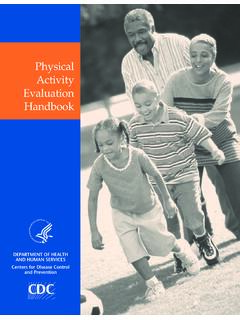Transcription of ‘Stakeholder Involvement’ - World Health Organization
1 stakeholder involvement Background paper prepared for the WHO/WEF Joint Event on Preventing Noncommunicable Diseases in the Workplace (Dalian/ China, September 2007) Authors: John Griffiths Hayley Maggs Emma George Contact author: John Griffiths work2health ltd E: T: +44 (0) 2920 388 477 M: +44 (0) 7798 502 548 F: +44 (0) 8707 626 208 W: 1 World Health Organization 2008 All rights reserved. Publications of the World Health Organization can be obtained from WHO Press, World Health Organization , 20 Avenue Appia, 1211 Geneva 27, Switzerland (tel.: +41 22 791 3264; fax: +41 22 791 4857; e-mail: Requests for permission to reproduce or translate WHO publications whether for sale or for noncommercial distribution should be addressed to WHO Press, at the above address (fax: +41 22 791 4806; e-mail: The designations employed and the presentation of the material in this publication do not imply the expression of any opinion whatsoever on the part of the World Health Organization concerning the legal status of any country, territory, city or area or of its authorities, or concerning the delimitation of its frontiers or boundaries.))
2 Dotted lines on maps represent approximate border lines for which there may not yet be full agreement. The mention of specific companies or of certain manufacturers products does not imply that they are endorsed or recommended by the World Health Organization in preference to others of a similar nature that are not mentioned. Errors and omissions excepted, the names of proprietary products are distinguished by initial capital letters. All reasonable precautions have been taken by the World Health Organization to verify the information contained in this publication. However, the published material is being distributed without warranty of any kind, either expressed or implied. The responsibility for the interpretation and use of the material lies with the reader. In no event shall the World Health Organization be liable for damages arising from its use. The named authors alone are responsible for the views expressed in this publication.
3 2 Section Page 1. Introduction Preamble Historical perspective The strengths and weaknesses of the setting The business case and other drivers for workplace Health promotion 3 3 5 6 6 2. promoting healthy diets and physical activity in the workplace who are the stakeholders? Rationale for stakeholder involvement Stakeholders and partners The key stakeholders, the rationale for their involvement , their role and competency A model of stakeholder engagement Stakeholders as enablers and resistors promoting good nutrition and physical activity in the workplace the resource implications for stakeholders 9 9 9 10 18 20 23 3. Interaction between stakeholders Mechanisms of interaction between different stakeholders Barriers to the stakeholder interaction and possible ways to overcome these barriers 24 24 29 4. Examples of multi stakeholder activities / programmes / experiences: Regional example Country examples NGO led example Company led examples 30 39 31 33 34 5.
4 Conclusions and recommendations 36 6. Limitations of the paper 38 7. References 39 31. Introduction Preamble Being in employment is Health enhancing, with people in employment enjoying better levels of Health than those who are unemployed (Waddell, 1). In addition to providing an income, work can also lead to improved self image, a sense of purpose to life, social interaction and personal development (Waddell, 1). The workplace has long been considered a suitable setting in which to promote Health and well being. There are several reasons for this, not least of which is that the workplace is a setting in which a large proportion of the adult (working aged) population can be reached with messages about Health and well-being. Associated with this is that many people who make up the workforce come from groups who are traditionally hard to reach with messages about Health , wellbeing and lifestyle, such as males and lower socio-economic groups.
5 A second major driver for workplace Health promotion (WHP hereafter) is that it has a positive impact on the economic well-being of an organisation and, in turn, the creation of wealth in the community as a whole. Key reasons that provide a rationale for WHP activity include: The aging population in many countries and the need to have older people who can remain healthy and economically active The increasing diversity of the workforce The requirement for high levels of workability among employees The need to recruit and retain high quality employees To have a workforce that is fit, flexible and efficient (workability) requires an organisation to have policies and approaches that: Enable and equip people to remain in work later in life Reduce the loss of experienced workers from the workforce improve retention Improve the quality of life both inside and outside work for all workers especially older workers Given the known benefits that accrue to organisations (and their employees) that implement workplace Health promotion initiatives, the considerable potential of workplace Health promotion can clearly be seen.
6 However employer engagement in the promotion of employee Health and well being is far from high. The key question then is how can more employers be encouraged to become involved and what systems and measures need to be in place in order for this to happen? The immediate need for action to be taken is made more pressing by demographic change and the continuing rise in lifestyle related chronic diseases such as obesity, Type II mature onset diabetes, CHD and stroke, the statistics for which are alarming. In 2006 the World 4 Health Organisation estimated that there were billion adults (aged 15+) who were overweight and at least 400 million adults who were clinically obese, predicting that by 2015 approximately billion adults will be overweight and more than 700 million obese (WHO, 2). Similar statistics relating to Type II diabetes and CHD are of equal concern with an estimated 120 million people World -wide affected by type 2 diabetes which is predicted to almost double to 215 million by 2010 (British Nutrition Foundation, 3) and an estimated 17 million people each year dying of cardiovascular diseases, in particular heart attacks and strokes (WHO, 4).
7 As this paper will describe, the workplace provides an ideal setting in which to raise awareness and promote behaviour change in terms of nutrition and physical activity , but that to achieve the considerable potential of the workplace all stakeholders must be completely committed and fully involved. In order to aid our understanding two complementary definitions of workplace Health promotion should be examined. The first, from Wynne (5) states that WHP, is directed at the underlying causes of ill Health ; combines diverse methods of approach; aims at effective worker participation; and is not primarily a medical activity , but should be part of work organisation and working conditions . The second definition was developed by the European Network for Workplace Health Promotion (ENWHP) in 1997. This states that, WHP is the combined efforts of employers, employees and society to improve the Health and well-being of people at work (6). This is achieved through a combination of: Improving the work organisation and the working environment promoting the active participation of employees in Health activities Encouraging personal development (6) The ENWHP statement goes on to note that WHP involves an organisational commitment to improving the Health of the workforce; providing employees with appropriate information; having policies and practices which help employees to make healthy choices; and recognising that organisations have an impact on people.
8 Using the WHO Ottawa Charter (7) as a basis, a template for WHP activity can be developed. This shows that WHP is based on: the building of healthy corporate policy the creation of a supportive working environment the development of employee skills (and knowledge) which are conducive to Health the strengthening of workforce action towards Health the re-orienting of occupational Health services Many countries, and indeed notable WHO documents, set out clear public Health targets. These range in scope from specific targets on 5lifestyle issues such as a reduction in the levels of morbidity and mortality linked to certain behaviours tobacco and alcohol use, to more general targets focusing on the Health consequences of socio-economic factors such as a reduction in inequalities in Health . It can be reasonably concluded that WHP offers considerable potential in terms of the achievements of these targets and consequently bring about improvements in levels of public Health .
9 This statement is born out by research findings focusing on the outcomes of workplace interventions. The vielife / IHPM Health and Performance Research Study (8) was the first prospective controlled study that explored the link between Health and productivity in the workplace. The findings of the research highlight how Health promotion programmes within the workplace can significantly improve the Health status of individuals and enhance quality of life, as well as improve work performance by % and reduce short term sickness absence. If this effect were to be multiplied across all the employers in a country then the impact on overall employee wellbeing would be considerable, with benefits to Health at a population level being experienced for many years in the future. Historical perspective One of the first, if not the first report, to identify the workplace as a setting in which people s Health could be improved was the Lalonde Report published by the Canadian Ministry of National Health and Welfare in 1974.
10 The purpose of the Report was, to unfold a new perspective on the Health of Canadians and to thereby stimulate interest and discussion on future Health programs for Canada (9). In setting out a possible Health promotion strategy several courses of action were identified, including those that relate to the workplace and to the importance of stakeholder involvement in the promotion of employee Health and well being Enlistment of the support of employers of sedentary workers in the establishment of employee exercise programs ; and Enlistment of the support of trade unions representing sedentary workers in obtaining employee exercise programs. Lalonde(9). The issue of stakeholder involvement was also referred to in the Ottowa Charter (7), where it is stated that, Health promotion demands coordinated action by all concerned: by governments, by Health and other social and economic sectors, by nongovernmental and voluntary organisations, by local authorities, by industry and by the media and on the specific issue of work it is noted that, Work and leisure should be a source of Health for people.










